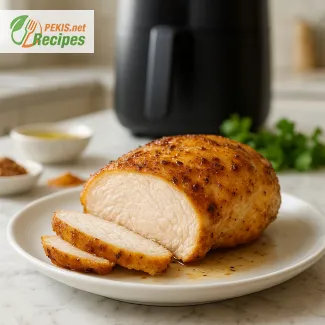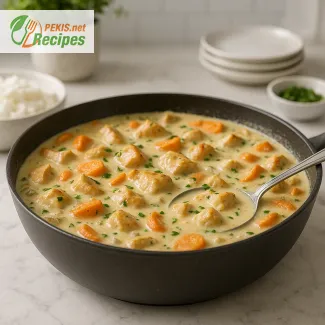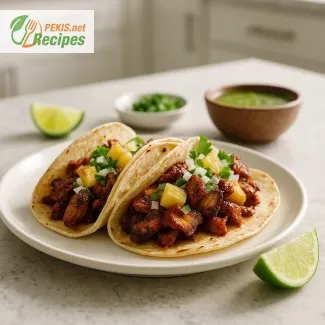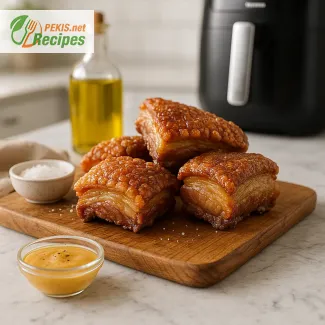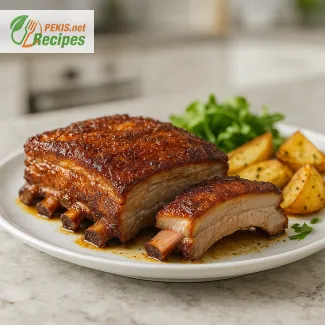A comforting, rich Quick Beef Goulash with Red Wine that tastes like a long-simmered classic but comes together fast. Tender beef, soft onions, smoky paprika and a splash of red wine create a silky, glossy sauce that clings to every bite. Inspired by traditional Hungarian flavours, this 30-minute version brings deep warmth and homestyle coziness to the table in no time.
Small details often make the biggest difference—like briefly blooming paprika in oil to unlock deeper warmth before adding the beef. That quick step transforms the entire pot. PEKIS – professional chef and recipe developer with over 25 years of experience in cooking and baking, specialized in European and international cuisine.
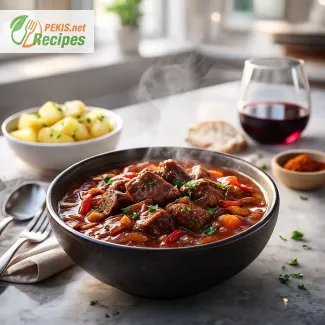
Weeknight beef goulash with red wine and silky paprika sauce
A cozy 30-minute beef goulash that tastes like it simmered all afternoon
Steam rising from the pot carries the scent of slow-cooked onions, smoky paprika and a splash of dry red wine, yet the spoon sinks into surprisingly tender beef after barely half an hour on the stove. Deep rust-red sauce clings to each piece of meat, glossy and velvety, with just enough thickness to coat noodles or soak into a slice of crusty bread. Every bite balances gentle sweetness from caramelised onions, the warmth of paprika and garlic, and the subtle acidity of tomato and wine that keeps the stew bright instead of heavy. It feels like a Sunday comfort dish, but fits into a busy weekday when time and energy are limited.
Classic beef goulash has its roots in Hungarian herdsmen’s kettles, where chunks of beef slowly simmered with onions, lard and paprika over open fires. The modern kitchen version often takes hours, but careful technique turns it into a 30-minute beef goulash without losing the soul of the dish. Choosing smaller, evenly cut pieces of beef, searing them properly and building flavour in layers with onions, tomato paste and wine gives a surprisingly rich result in a fraction of the usual time. The goal is a one-pot dinner that feels traditional and generous, yet realistic for weeknight cooking.
How quick beef goulash with red wine builds deep flavour fast
A successful quick beef goulash with red wine relies less on long cooking and more on technique:
- Beef – Smaller cubes from a relatively tender cut help the meat soften in 30 minutes while still keeping a meaty bite.
- Onions – A generous base of onions cooked until soft, translucent and lightly golden gives natural sweetness and body to the sauce.
- Paprika – Good quality sweet Hungarian paprika (with a touch of smoked paprika if you like) defines the flavour and colour; blooming it briefly in fat unlocks its aroma.
- Garlic and caraway – Finely chopped garlic and a pinch of caraway seeds add depth and a faint herbal note that keeps the stew interesting.
- Tomato paste – A spoonful of tomato paste caramelised in the pan adds umami, richness and helps the sauce cling to the beef.
- Red wine – A dry red wine deglazes the pan, dissolving the browned bits from the bottom and lending gentle acidity and complexity.
- Stock or broth – Beef or vegetable stock stretches the sauce into a proper stew consistency without diluting flavour.
Choosing the right beef cut for a 30-minute goulash
For a short simmer, very tough cuts never get the chance to fully break down. Lean but not dry cuts like sirloin tip, round or shoulder trimmed into small cubes tend to work best here. The pieces should sear quickly, stay juicy and become pleasantly tender rather than gelatinous. Patting the meat dry and seasoning it well before it hits the hot pan maximises browning and ensures a flavourful crust on each cube.
Building the red wine and paprika sauce
Once the meat is browned and set aside, the same pot becomes the base for a deeply flavoured sauce. Onions cook slowly in the leftover fat until soft and fragrant, followed by garlic and caraway. Tomato paste is then stirred in and cooked briefly until darkened and aromatic, concentrating its flavour. Paprika is sprinkled in and warmed gently so it releases colour and aroma without burning. Deglazing with red wine loosens all the caramelised bits at the bottom, and stock turns everything into a silky, brick-red gravy that thickens as the beef finishes cooking.
Serving ideas: sides that love beef goulash
Rich, saucy beef goulash with red wine begs for a side that can soak up every drop. Creamy mashed potatoes, buttered egg noodles or simple boiled potatoes all work beautifully, but one of the most satisfying options is crispy pan-fried potatoes with onions. If you want a dedicated guide, there is a separate recipe for golden, flavour-packed potatoes here: Perfect Pan-Fried Potatoes with Onion – Boiled First for Extra Flavor.
A spoonful of sour cream, some chopped fresh parsley and a crunchy side salad of cucumbers or mixed leaves cut through the richness of the sauce. The contrast between tender beef, silky gravy and crispy potatoes makes the whole plate feel balanced rather than heavy.
Why you’ll love this quick beef goulash
- Ready in about 30 minutes – fits comfortably into a busy weeknight.
- One-pot cooking – minimal dishes and easy cleanup.
- Deep, savoury flavour from onions, paprika and red wine without long simmering.
- Flexible serving options – works with potatoes, noodles, rice or bread.
- Easy to scale – straightforward to double for guests or meal prep.
Short origin story and how this version fits in
Traditional goulash (gulyás) started as a humble beef and onion stew carried by Hungarian shepherds, evolving into a national dish and then a beloved comfort food across Central Europe. Regional variations use different cuts of beef, more or less paprika, potatoes in the pot or on the side, and sometimes even cabbage or peppers. This 30-minute stovetop goulash keeps the essence: beef, onions, paprika and a rich, brick-red sauce. The use of red wine and a controlled, higher simmer is what adapts it for modern kitchens and tight schedules, offering a dish that still feels authentic on a weeknight.
Storage and make-ahead tips for beef goulash
Even though this is designed as a quick beef goulash, it stores and reheats well:
- In the fridge – Once cooled, keep it in an airtight container for 2–3 days. The flavours often become even deeper and more rounded by the next day.
- Reheating – Warm gently on the stove with a splash of water or stock, stirring until the sauce returns to a smooth, glossy consistency.
- Make-ahead – You can cook the stew earlier in the day, chill it, then reheat while you prepare fresh potatoes, noodles or bread.
The sauce may thicken as it stands; loosening it with a little liquid restores the original silky texture without compromising flavour.
Complementary dessert: something light after a rich stew
After a bowl of hearty beef goulash, a dessert that feels lighter yet still comforting works best. A moist yogurt-based cake with fruit and spices mirrors the cosy mood without being heavy. For inspiration, there is a separate recipe for a soft, not-too-sweet cake here: Moist Apple Cinnamon Yogurt Cake – Easy Homemade Dessert Recipe. The gentle apple and cinnamon notes pair beautifully with the paprika warmth in the main dish.
Creative variations on quick beef goulash
- Smoky twist – Add a pinch of smoked paprika or diced smoked sausage for extra depth.
- Vegetable-rich version – Stir in bell peppers, carrots or celery for more texture and colour.
- Creamy finish – Swirl a spoonful of sour cream or crème fraîche into the sauce just before serving for a richer, slightly tangy result.
- Spicy option – Add a pinch of hot paprika or chili flakes if you like more heat.
- Noodle bowl style – Serve the goulash over wide egg noodles with plenty of sauce for a comforting pasta-style dish.
Semantics and structure: beef goulash with red wine, onions and paprika
When thinking about this dish as part of a weekly rotation, it sits somewhere between a classic beef stew, a paprika-driven Hungarian goulash and a fast skillet dinner. The combination of beef, onions, garlic, paprika, tomato paste, red wine and stock creates a flavour profile that is instantly recognisable yet easy to adapt. Keeping the method focused on high-impact browning, properly cooked onions and careful seasoning is what allows this quick beef goulash with red wine to deliver satisfying depth in a short time, ready to be followed by a simple side and a gentle dessert.
- Heat the vegetable oil in a large pot over medium-high heat. Add the beef cubes in batches and sear until deeply browned on all sides. Remove and set aside.
- Add the chopped onions to the same pot and cook until soft, translucent and lightly golden. Add minced garlic and cook briefly until fragrant.
- Stir in tomato paste and cook for 1 minute until it darkens slightly.
- Sprinkle in sweet paprika, smoked paprika and caraway seeds, stirring gently so the spices bloom without burning.
- Add the flour and mix to coat the onions and spices evenly.
- Deglaze the pot with red wine, scraping the bottom to release any browned bits.
- Pour in the beef stock, return the seared beef to the pot, and mix well.
- Season with salt, black pepper and add the bay leaf.
- Bring to a simmer, then cook uncovered for about 20 minutes until the beef becomes tender and the sauce thickens into a silky consistency.
- Remove the bay leaf, adjust seasoning if needed and serve topped with chopped parsley and a spoonful of sour cream if desired.
FAQ questionCan I really make beef goulash with red wine in just 30 minutes?
Yes, as long as the method is adapted for speed. Using smaller beef cubes, a hot pan for deep browning and a lively simmer instead of a very gentle one means the meat becomes tender enough in around 30 minutes. You won’t get the same texture as a 3-hour braise, but you still achieve juicy beef, a silky paprika sauce and impressive depth of flavour thanks to onions, tomato paste and red wine cooked in layers.
FAQ questionWhat kind of beef works best for a quick goulash?
For a short cooking time, choose cuts that are lean but not tough, such as sirloin tip, round or shoulder trimmed into small cubes. Very hard-working cuts designed for long braises can stay chewy if cooked only briefly. Even with the right cut, it helps to cut the beef into smaller pieces, pat them dry and brown them well so the outside is flavourful and the inside cooks through without drying out.
FAQ questionWhich red wine should I use for this goulash?
A dry red wine with moderate body works best—think basic Merlot, Cabernet Sauvignon, Rioja or a simple table red. Avoid very sweet or heavily oaked wines, which can make the sauce taste cloying or too strong. The wine’s job is to deglaze the pan, add acidity and bring a subtle fruity depth to the paprika sauce, not to dominate it. If in doubt, choose a wine that tastes good enough to drink but doesn’t have to be expensive.
FAQ questionHow do I make the sauce thick and glossy without overcooking the meat?
The key is to build natural thickness before adding much liquid. First, cook onions slowly until soft and lightly golden. Then toast tomato paste until darker and fragrant, stir in paprika and flour, and only then add wine and stock. This creates a rich base that thickens as the goulash simmers. Keeping the pot at a steady, uncovered simmer lets moisture evaporate and concentrates the sauce, so it becomes velvety and glossy while the beef finishes cooking.
FAQ questionWhat can I serve with quick beef goulash with red wine?
This goulash is all about the sauce, so choose sides that soak it up. Mashed potatoes, buttered noodles, rice or crusty bread are all classic options. For something extra satisfying, pair it with crispy pan-fried potatoes with onions, which add a contrasting crunch to the soft beef and silky sauce. A simple green salad or cucumber salad on the side helps cut through the richness and keeps the plate balanced.
FAQ questionCan I make this goulash ahead and reheat it?
Absolutely. In fact, the flavours often become deeper and more rounded after a night in the fridge. Once cooled, store the goulash in an airtight container for up to 2–3 days. Reheat gently on the stove, adding a splash of water or stock if the sauce has thickened too much. Warm it just until steaming and smooth, not furiously boiling, to keep the beef tender and the sauce silky, not grainy.
Rich flavours, quick preparation and a warm, rustic character make this dish a dependable choice for busy days. The combination of tender beef, soft onions and paprika creates a sauce that feels slow-cooked, even though the method stays fast and practical. Each step builds depth, giving the final bowl a comforting balance of sweetness, acidity and gentle smokiness.
The splash of red wine adds brightness and complexity without overpowering the traditional profile. It blends into the sauce, lifting the paprika and giving the beef a richer, rounder taste. Even with minimal ingredients, the result feels generous and satisfying, perfect for pairing with potatoes, noodles or bread.
Short cooking time becomes an advantage rather than a limitation, keeping the flavours clear and the textures distinct. The beef stays juicy, the onions melt into the sauce, and the spices remain fragrant. This combination makes the dish suitable both for weeknight meals and cosy weekend dinners.
Small adjustments—like blooming paprika, caramelising tomato paste or deglazing at the right moment—ensure every batch turns out consistently silky, aromatic and full of character. The simplicity of the process means the recipe can easily become part of a regular rotation while still offering that familiar, homestyle comfort.
Allergens present in the recipe
- Gluten: from all-purpose flour
- Dairy: from optional sour cream
How to remove allergens and gluten
- Replace all-purpose flour with cornstarch or rice flour to make the recipe gluten-free.
- Omit sour cream or use a dairy-free alternative such as coconut yogurt or soy-based cream.
- Vitamin B12 (µg): 1.9 – supports red blood cell formation
- Iron (mg): 3.2 – contributes to oxygen transport
- Zinc (mg): 5.1 – important for immune function
- Potassium (mg): 430 – supports muscle and nerve function
- Vitamin B6 (mg): 0.4 – assists metabolism
- Lycopene (mg): 2.1 – helps protect cells from oxidative stress
- Polyphenols (mg): 18 – naturally present in red wine, support heart health
- Beta-carotene (mg): 0.3 – contributes to cellular protection
